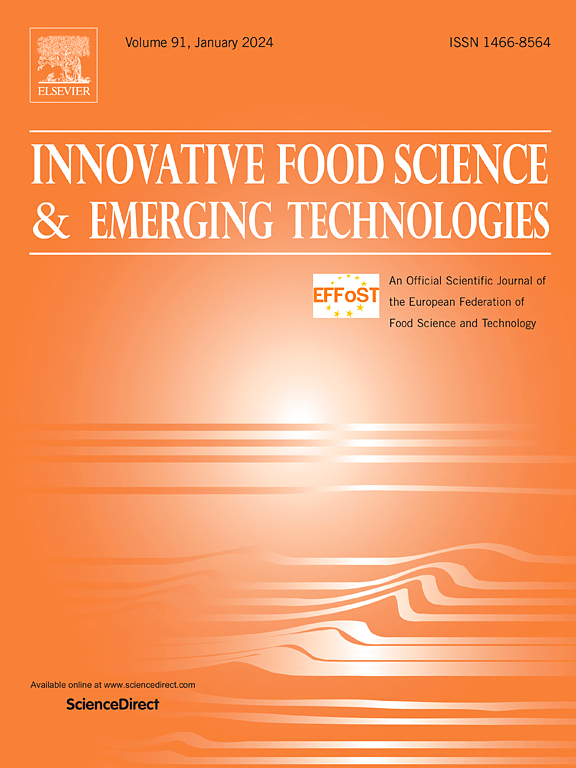Steam-exploded Laminaria japonica polysaccharide improved set yogurt quality: Based on flavor, storage stability and dynamic in vitro digestive properties
IF 6.3
1区 农林科学
Q1 FOOD SCIENCE & TECHNOLOGY
Innovative Food Science & Emerging Technologies
Pub Date : 2025-01-15
DOI:10.1016/j.ifset.2025.103933
引用次数: 0
Abstract
Laminaria japonica polysaccharide (LJP) is an important nutrient of Laminaria japonica, and the extraction rate and the bioactivity of LJP were improved with the steam explosion (SE) method according to our preliminary research. Here, the effects of steam-exploded Laminaria japonica polysaccharide (LJPS) on flavor, storage stability, and dynamic in vitro digestive properties of set yogurt were investigated in this study. The results suggested that the addition of 0.1 % LJP and LJPS maintained the taste and the odor of set yogurt. In addition, the water holding capacity was increased significantly by 1.067 and 1.066 folds with LJP and LJPS compared with the control groups, respectively. Furthermore, the water distribution was optimized with the addition of LJP and LJPS. In particular, LJP improved the adhesiveness of set yogurt by texture profile analysis. Moreover, the viability of Lactobacilli and Lactococci was sustained during the dynamic in vitro digesting process with LJP and LJPS. Overall, the study provides theoretical guidance for the application of marine plant polysaccharides in the food industry.
蒸汽爆破海带多糖改善酸奶品质:基于风味、贮存稳定性和动态体外消化特性
海带多糖(Laminaria japonica多糖,LJP)是海带的一种重要营养物质,通过初步研究,采用蒸汽爆炸法(蒸汽爆炸法)提高了海带多糖的提取率和生物活性。本文研究了蒸汽爆破海带多糖(LJPS)对酸奶风味、贮藏稳定性和动态体外消化特性的影响。结果表明,添加0.1%的LJP和LJPS后,酸奶的口感和香气保持不变。此外,与对照组相比,LJP和LJPS的持水量分别显著提高了1.067倍和1.066倍。此外,通过添加LJP和LJPS,优化了水分分配。通过构形分析,LJP提高了酸奶的黏附性。此外,在LJP和LJPS的动态体外消化过程中,乳酸杆菌和乳球菌的活力保持不变。本研究为海洋植物多糖在食品工业中的应用提供了理论指导。
本文章由计算机程序翻译,如有差异,请以英文原文为准。
求助全文
约1分钟内获得全文
求助全文
来源期刊
CiteScore
12.00
自引率
6.10%
发文量
259
审稿时长
25 days
期刊介绍:
Innovative Food Science and Emerging Technologies (IFSET) aims to provide the highest quality original contributions and few, mainly upon invitation, reviews on and highly innovative developments in food science and emerging food process technologies. The significance of the results either for the science community or for industrial R&D groups must be specified. Papers submitted must be of highest scientific quality and only those advancing current scientific knowledge and understanding or with technical relevance will be considered.

 求助内容:
求助内容: 应助结果提醒方式:
应助结果提醒方式:


